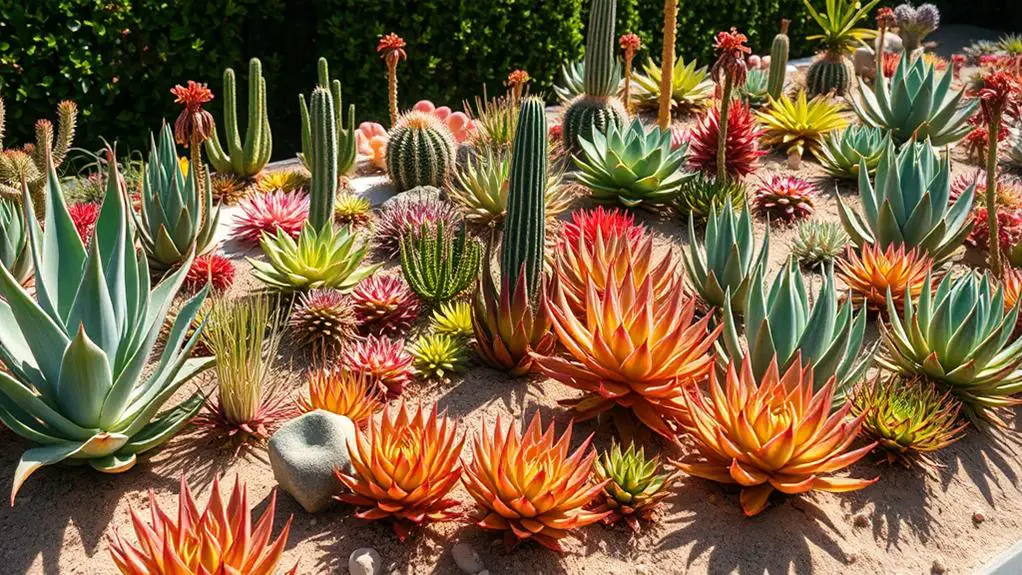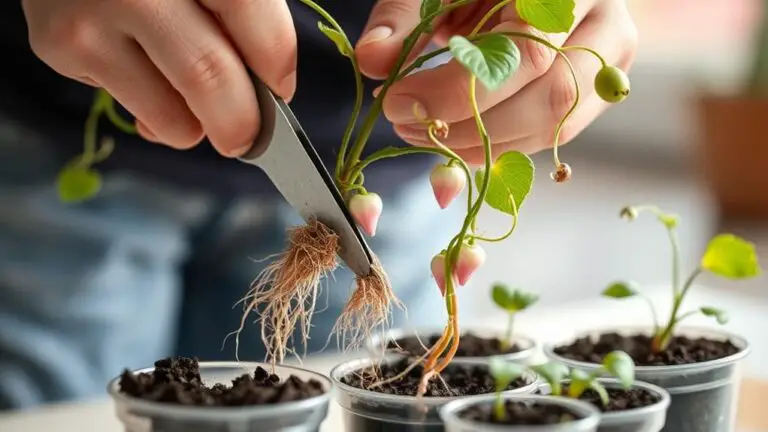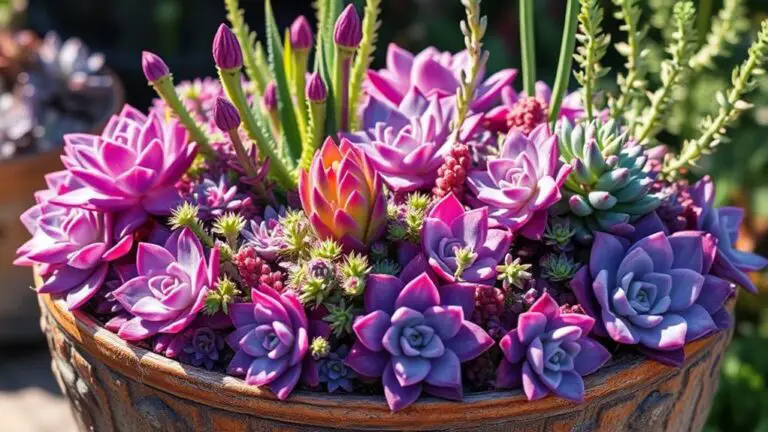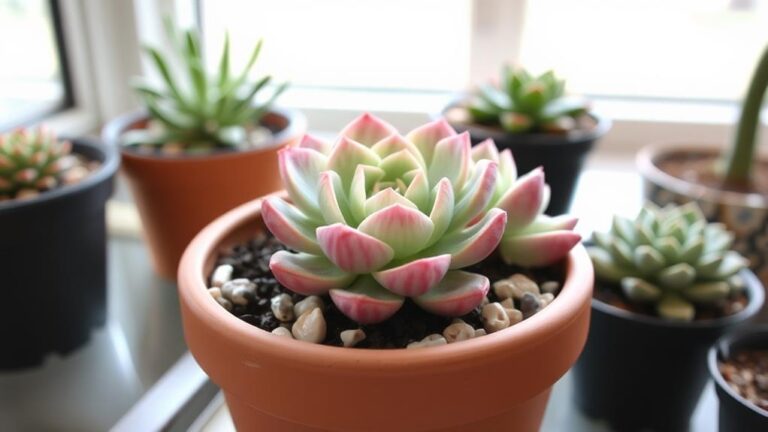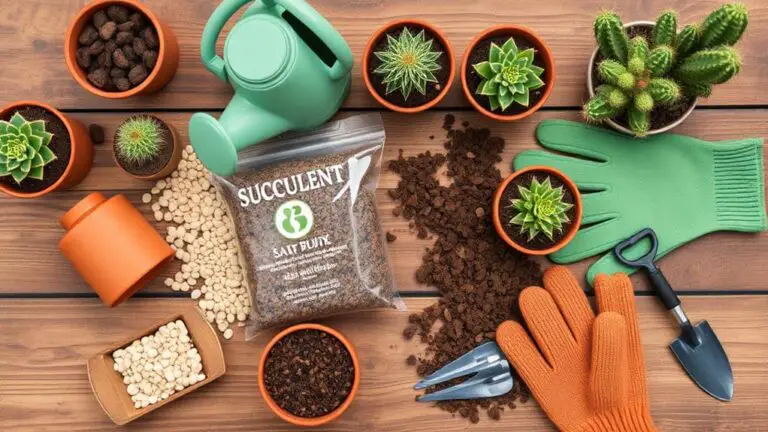Top 7 Sun and Heat Loving Succulents for Your Garden
When designing your sun-drenched garden, you'll want to choose plants that not only withstand the heat but thrive in it. Among the top contenders are seven succulents that bring both resilience and beauty to your outdoor space. Imagine the vibrant rosettes of Echeveria Perle Von Nurnberg and the enchanting hues of Graptoveria Fred Ives. But that's just the beginning. How about adding a touch of striking shape with Echinocactus Grusonii or the charming Powder Puff Cactus? Let's explore the unique attributes of each succulent, ensuring your garden becomes a low-maintenance, sun-loving haven.
Echeveria Perle Von Nurnberg
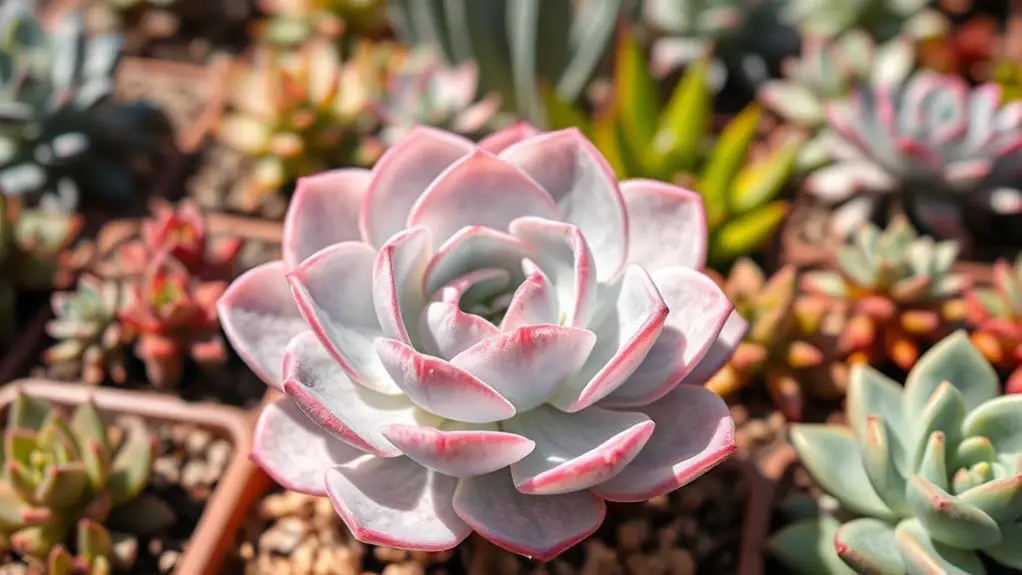
Echeveria Perle von Nurnberg is a standout succulent that captivates with its rosette shape and stunning lavender-pink hues, which become even more vibrant under bright sunlight. This succulent is a perfect addition to any garden, especially if you're looking for full sun plants. It thrives with at least six hours of direct sunlight daily, making its colors even more striking and its growth compact.
You'll find that Echeveria Perle von Nurnberg is incredibly drought-tolerant. It prefers well-draining soil, which is perfect for dry, hot climates. Overwatering can lead to root rot, so it's best to let the soil dry out between waterings.
This succulent can grow up to 6 inches in height and spread about 12 inches wide, making it ideal for rock gardens or container arrangements.
In the spring and summer, Echeveria Perle von Nurnberg will reward you with flower spikes that produce beautiful tubular pink flowers, attracting pollinators to your garden. If you enjoy other succulents like Echeveria Agavoides, you'll likely appreciate this variety as well.
Its resilience and beauty make it a fantastic choice for any garden enthusiast.
Sedum Nussbaumerianum
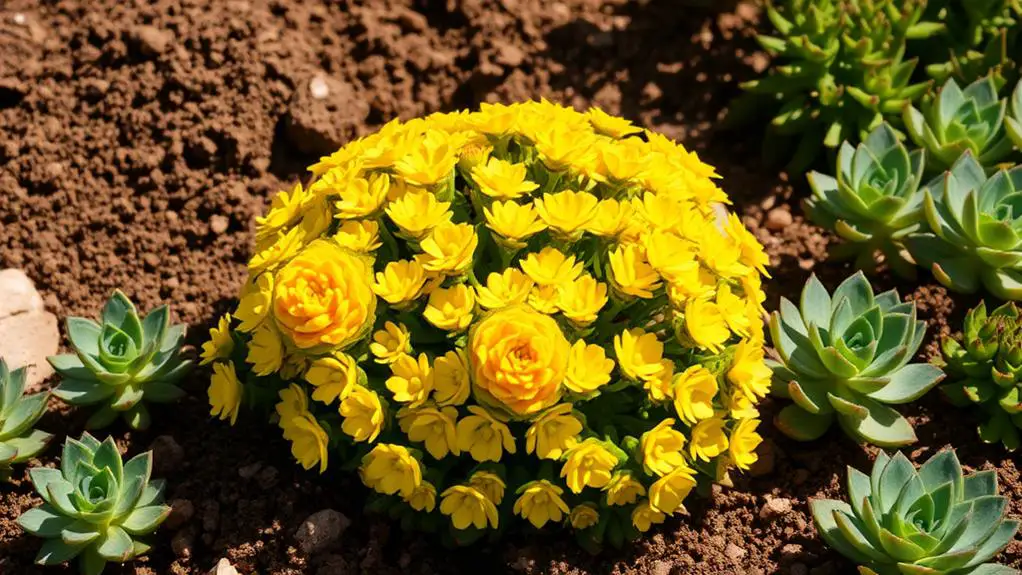
Sedum nussbaumeranum, also known as Orange Delight, loves the sun and needs at least six hours of direct sunlight each day to show off its beautiful jelly-orange-red leaves.
You don't have to worry much about watering because it prefers dry soil, making it perfect for drought conditions.
For seasonal care, this resilient plant can handle cold temperatures down to 14°F, so it's great for areas with occasional frost.
Sun Exposure Benefits
Basking in direct sunlight for at least six hours a day, the Orange Delight, or Sedum nussbaumerianum, truly flourishes under such exposure. This succulent loves the full sun, and it's evident in its vibrant coloration and robust growth. You'll notice that the more sun it gets, the more striking its orange hues become. The sun's rays help this succulent maintain its health and beauty, making it a standout in any garden.
There are several benefits to giving your Sedum nussbaumerianum plenty of sunlight:
- Enhanced Coloration: Direct sunlight intensifies its orange tones, making the plant look more attractive.
- Healthy Growth: Full sun provides the energy needed for robust and vigorous growth.
- Flower Production: Sunlight encourages the growth of star-shaped yellow flowers, adding beauty and attracting pollinators.
Not only does this sun-loving succulent thrive in bright conditions, but it's also incredibly drought-resistant. Its thick, waxy leaves are designed to prevent moisture loss, enabling it to endure higher temperatures effortlessly.
This makes the Orange Delight a perfect choice for hot, dry climates where water conservation is key. Plus, it's low-maintenance, so even if you're busy or new to gardening, you'll find it easy to care for.
Watering and Soil Needs
While the Orange Delight thrives in full sun, it's also important to understand its watering and soil needs to guarantee its continued health. This succulent plant loves well-draining soil, which helps prevent root rot. Choosing a gritty or sandy mix will give your Sedum nussbaumerianum the best chance to flourish.
When it comes to watering, remember that less is more. This plant prefers the soil to dry out completely between waterings, especially during the warm summer months. Overwatering can be a common mistake, so keep an eye on the soil moisture.
During high heat and intense sunlight, increased evaporation rates can lead to water stress. Regularly check the soil to confirm it's not too dry.
The Orange Delight is drought-resistant, making it a perfect choice for gardens in dry climates where conserving water is significant. Adjusting your watering schedule seasonally is important.
In autumn and winter, when the plant's growth slows down, reduce the frequency of watering. This succulent's soil needs are straightforward but essential for its health. By following these tips, you'll keep your Orange Delight thriving and beautiful all year round.
Seasonal Care Tips
Caring for your Orange Delight through the changing seasons guarantees it remains healthy and vibrant. As a sun succulent, Sedum nussbaumerianum loves full sunlight, needing at least six hours daily to achieve its stunning colors. With proper care, this resilient plant will thrive all year round.
To confirm your Orange Delight flourishes, keep these seasonal tips in mind:
- Spring and Summer: During the active growing season, give your succulent a light feed to encourage growth and flowering. Use a balanced fertilizer, but don't overdo it—once a month is enough.
- Autumn: As temperatures cool, reduce the amount of water and fertilizer. Let the soil dry out completely between waterings to prevent root rot.
- Winter: Watch out for overwatering and confirm your plant has well-draining soil. Using a gritty media can help manage moisture. Also, keep an eye on pests and diseases, ensuring good air circulation around your plant.
Heat conditions can stress plants, but with these tips, your Orange Delight will stay strong.
Echinocactus Grusonii

Echinocactus grusonii, commonly known as the Golden Barrel Cactus, stands out in any garden with its striking spherical shape and golden spines. This unique cactus thrives in full sun, making it perfect for those sunny spots in your garden.
It's highly drought-resistant, so you won't need to worry about frequent watering, especially once it's established. This makes it ideal for arid climates where water conservation is a priority.
The Golden Barrel Cactus can grow up to 3 feet in height and 2 feet in diameter. Its distinctive ribbed sides, covered in golden spines, not only look amazing but also protect the plant from herbivores.
These features make it a fascinating focal point in your garden, drawing attention and admiration from visitors.
One of the best things about Echinocactus grusonii is its resilience. It can tolerate temperatures as low as 20°F (-6°C), so it's suitable for regions with mild winters.
Plus, it's a slow-growing cactus that can live for several decades, offering a long-term addition to your succulent collection.
With minimal care, this cactus will thrive and enhance your garden's beauty for years to come.
Graptoveria Fred Ives
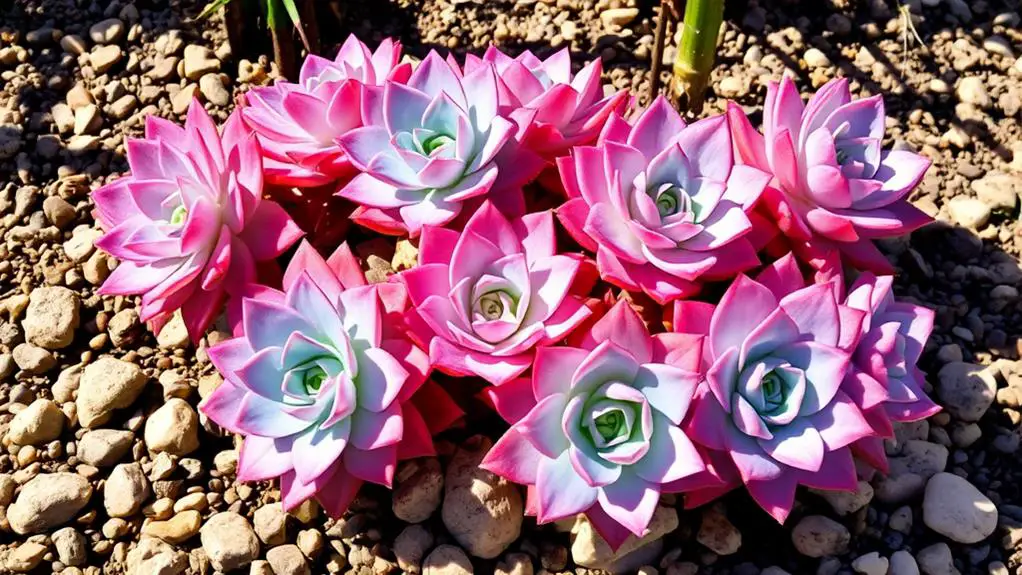
If you're looking for a vibrant succulent, Graptoveria Fred Ives is a fantastic choice.
It thrives in full sun, needing at least six hours daily to show off its stunning pink to lavender colors.
Remember to plant it in well-draining soil and let the soil dry out completely between waterings to keep it healthy and happy.
Sunlight Tolerance Features
Many succulent enthusiasts find Graptoveria Fred Ives to be a perfect match for sunny gardens due to its remarkable sunlight tolerance features. This hybrid succulent thrives in full sun, needing at least six hours of direct sunlight daily to achieve its best growth and vibrant colors.
When exposed to ample sunlight, its fleshy, paddle-shaped leaves can display stunning shades of pink and lavender, adding a splash of color to your garden.
To make the most of Graptoveria Fred Ives's sunlight tolerance, follow these three key steps:
- Gradual Acclimatization: If your plant is adapting from partial shade, gradually expose it to full sun to prevent sunburn and stress.
- Handling Harsh Sunlight: This succulent can withstand harsh sunlight and high temperatures, making it ideal for hot and dry conditions.
- Drought-Tolerance: Graptoveria Fred Ives is drought-tolerant and prefers well-draining soil, so you won't have to worry about it wilting during dry spells.
Its resilience to full sun and ability to handle low humidity make it a fantastic addition to any sunny garden or landscape.
With a bit of care and attention, your Graptoveria Fred Ives will thrive and bring beauty to your outdoor space.
Watering and Soil Tips**
Caring for Graptoveria Fred Ives involves mastering the balance of watering and soil conditions to guarantee healthy growth. This sun-loving succulent thrives in well-draining soil, which prevents root rot, especially in high-sun environments where water evaporates quickly.
To get the soil just right, mix in gritty components like perlite or sand. These help the soil drain better, mimicking the arid conditions Graptoveria Fred Ives loves.
When it comes to watering, pay attention to the seasons. During the growing season, water your plant more frequently but let the soil dry out completely between waterings. This prevents the roots from becoming over-saturated.
Keep an eye on your plant for signs of stress, like yellowing leaves, which suggest it's time to adjust your watering schedule.
In the winter, Graptoveria Fred Ives enters dormancy and needs considerably less water. Reduce watering during these cooler months to avoid root damage.
This succulent requires minimal moisture in winter, making it easier to care for during this period.
Euphorbia Ferox

Euphorbia ferox, a standout among succulents, is celebrated for its distinctive, spiny appearance and remarkable drought tolerance. If you're looking to add some texture and interest to your garden, this plant is a great choice.
It's known for thriving in full sun and can handle extreme temperatures up to 122°F (50°C). This makes it perfect for hot, dry gardens where other plants might struggle.
Euphorbia ferox is quite similar to Euphorbia mammillaris, another drought-tolerant succulent, but it stands out with its thick, fleshy stems that store water. This allows it to survive long periods without rainfall.
Come spring, you'll be delighted by its small, yellow flowers that add a pop of color when many other plants aren't in bloom.
To guarantee your Euphorbia ferox thrives, keep these tips in mind:
- Plant in well-draining soil: Prevent root rot by avoiding overly wet conditions.
- Provide full sun: This succulent loves lots of direct sunlight.
- Water sparingly: Its water-storing stems mean it doesn't need frequent watering.
Mammillaria Gracilis

Mammillaria gracilis, commonly known as the Powder Puff Cactus, is a charming addition to any sun-soaked garden. This delightful succulent thrives in full sun, making it perfect for hot, dry environments. Its small, cylindrical stems are covered in fine white spines, giving it a fluffy, almost snow-like appearance that's simply enchanting.
You'll love the burst of color this cactus brings to your garden. During late spring and summer, Mammillaria gracilis produces vibrant pink to white flowers that appear in clusters. These flowers are eye-catching and add a lovely contrast to the plant's soft, white spines.
One of the best things about Mammillaria gracilis is that it's drought-tolerant. It requires minimal watering, making it ideal for those who prefer low-maintenance gardening. Just make sure your garden has good drainage, as this cactus doesn't like standing water.
This species is also quite hardy. It can tolerate temperatures as low as 20°F (-6°C), although it prefers warmer climates.
If you're looking for a beautiful, easy-to-care-for succulent that thrives in full sun, the Mammillaria gracilis is an excellent choice for your garden.
Echeveria Lilacina
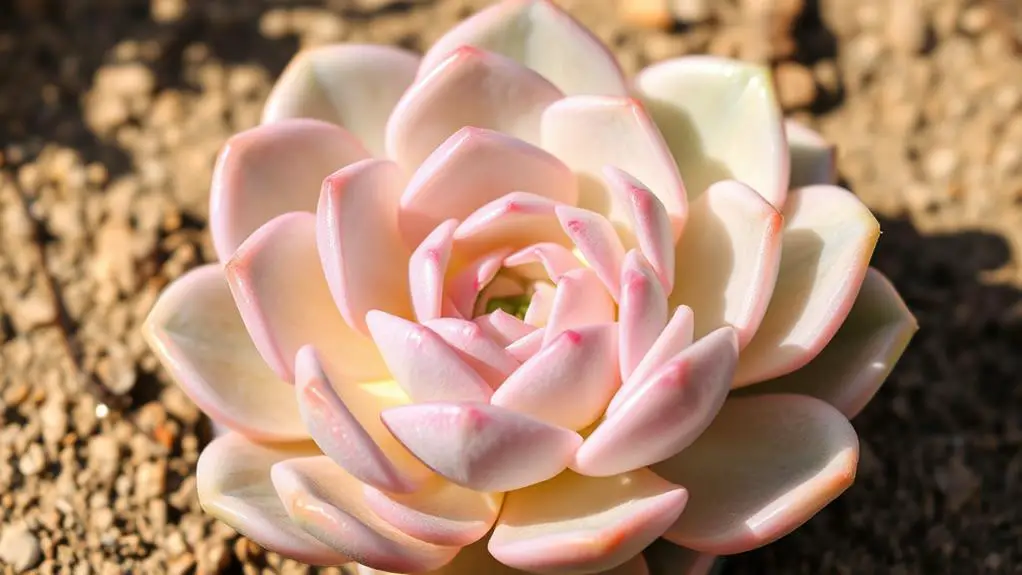
When it comes to sun and heat loving succulents, Echeveria lilacina, also known as the "Ghost Echeveria," stands out with its striking appearance. This beautiful plant features pale lavender to silvery-green leaves that form a rosette shape.
It's a popular choice for gardens and containers because of its unique look and easy care.
To keep Echeveria lilacina at its best, you'll need to guarantee it gets plenty of sunlight. This succulent thrives in full sun, requiring at least six hours of direct sunlight daily. This helps maintain its vibrant color and encourages robust growth.
Here are three key tips for growing Echeveria lilacina successfully:
- Full Sun: Place it in a sunny spot where it can soak up the rays.
- Well-Draining Soil: Use soil that drains well to prevent root rot. Let the soil dry out completely between watering sessions.
- Drought-Tolerant: This succulent doesn't need frequent watering, making it perfect for low-maintenance gardens in hot and dry climates.
During the growing season, a light fertilization can boost its growth. However, be careful not to over-fertilize.
With these tips, your Echeveria lilacina will thrive and add beauty to your garden.
Frequently Asked Questions
What Succulents Can Be in Full Sun?
You can place succulents like Sedum sediforme, Echeveria lilacina, Echinocactus grusonii, Mammillaria gracilis, Graptoveria Fred Ives, and Yucca species in full sun. Gradual acclimatization prevents stress and sunburn.
Is It Okay to Put Succulents in Direct Sunlight?
Yes, it's okay to put succulents in direct sunlight, but you should gradually introduce them to prevent stress. Monitor for signs of sunburn like leaf discoloration, and adjust watering as increased sunlight leads to higher evaporation rates.
Can Succulents Take Full Sun Outdoors?
Yes, succulents can take full sun outdoors. Gradually acclimate them to prevent sunburn. Make certain they get at least six hours of direct sunlight daily, and monitor soil moisture to avoid overwatering. Adjust watering during high temperatures.
Do Succulents Do Well in Extreme Heat?
Yes, succulents do well in extreme heat. They store water in their leaves, making them drought-resistant. Just guarantee they get enough sunlight and are planted in well-draining soil to prevent root rot.
Conclusion
You're ready to create a stunning, sun-soaked garden with these heat-loving succulents! By adding Echeveria Perle Von Nurnberg, Sedum Nussbaumerianum, Echinocactus Grusonii, Graptoveria Fred Ives, Euphorbia Ferox, Mammillaria Gracilis, and Echeveria Lilacina, you'll enjoy vibrant colors, unique shapes, and low-maintenance care. Don't worry if you're new to gardening—these plants are hardy and forgiving. Just give them plenty of sunlight, and watch your garden thrive. You've got this!

